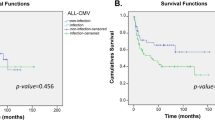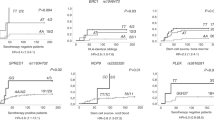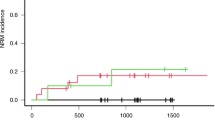Abstract
Individual differences in drug efficacy or toxicity can be influenced by genetic factors. We investigated whether polymorphisms of pharmacogenes that interfere with metabolism of drugs used in conditioning regimen and graft-versus-host disease (GvHD) prophylaxis could be associated with outcomes after HLA-identical hematopoietic stem cell transplantation (HSCT). Pharmacogenes and their polymorphisms were studied in 107 donors and patients with leukemia receiving HSCT. Candidate genes were: P450 cytochrome family (CYP2B6), glutathione-S-transferase family (GST), multidrug-resistance gene, methylenetetrahydrofolate reductase (MTHFR) and vitamin D receptor (VDR). The end points studied were oral mucositis (OM), hemorrhagic cystitis (HC), toxicity and venoocclusive disease of the liver (VOD), GvHD, transplantation-related mortality (TRM) and survival. Multivariate analyses, using death as a competing event, were performed adjusting for clinical factors. Among other clinical and genetic factors, polymorphisms of CYP2B6 genes that interfere with cyclophosphamide metabolism were associated with OM (recipient CYP2B6*4; P=0.0067), HC (recipient CYP2B6*2; P=0.03) and VOD (donor CYP2B6*6; P=0.03). Recipient MTHFR polymorphisms (C677T) were associated with acute GvHD (P=0.03), and recipient VDR TaqI with TRM and overall survival (P=0.006 and P=0.04, respectively).Genetic factors that interfere with drug metabolisms are associated with treatment-related toxicities, GvHD and survival after HLA-identical HSCT in patients with leukemia and should be investigated prospectively.
This is a preview of subscription content, access via your institution
Access options
Subscribe to this journal
Receive 12 print issues and online access
$259.00 per year
only $21.58 per issue
Buy this article
- Purchase on Springer Link
- Instant access to full article PDF
Prices may be subject to local taxes which are calculated during checkout




Similar content being viewed by others
References
Evans WE, Johnson JA . Pharmacogenomics: the inherited basis for interindividual differences in drug response. Annu Rev Genomics Hum Genet 2001; 2: 9–39.
Dickinson AM, Middleton PG, Rocha V, Gluckman E, Holler E . Genetic polymorphisms predicting the outcome of bone marrow transplants. Br J Haematol 2004; 127: 479–490.
Evans WE, McLeod HL . Pharmacogenomics—drug disposition, drug targets, and side effects. N Engl J Med 2003; 348: 538–549.
Cavet J, Middleton PG, Segall M, Noreen H, Davies SM, Dickinson AM . Recipient tumor necrosis factor-alpha and interleukin-10 gene polymorphisms associate with early mortality and acute graft-versus-host disease severity in HLA-matched sibling bone marrow transplants. Blood 1999; 94: 3941–3946.
Lin MT, Storer B, Martin PJ, Tseng LH, Gooley T, Chen PJ et al. Relation of an interleukin-10 promoter polymorphism to graft-versus-host disease and survival after hematopoietic-cell transplantation. N Engl J Med 2003; 349: 2201–2210.
Rocha V, Franco RF, Porcher R, Bittencourt H, Silva Jr WA, Latouche A et al. Host defense and inflammatory gene polymorphisms are associated with outcomes after HLA-identical sibling bone marrow transplantation. Blood 2002; 100: 3908–3918.
Socie G, Loiseau P, Tamouza R, Janin A, Busson M, Gluckman E et al. Both genetic and clinical factors predict the development of graft-versus-host disease after allogeneic hematopoietic stem cell transplantation. Transplantation 2001; 72: 699–706.
Xie HJ, Yasar U, Lundgren S, Griskevicius L, Terelius Y, Hassan M et al. Role of polymorphic human CYP2B6 in cyclophosphamide bioactivation. Pharmacogenomics J 2003; 3: 53–61.
Jones RB, Matthes S, Cagnoni P . Pharmacokinetics. In: Armitage JO, Antman KH (eds). High-Dose Cancer Therapy: Pharmacology, Hematopoietins, Stem Cells, 3rd edn, Lippincott Williams and Wilkins: Philadelphia, 2000, pp 49–68.
Grenet O, Bobadilla M, Chibout SD, Steiner S . Evidence for the impairment of the vitamin D activation pathway by cyclosporine A. Biochem Pharmacol 2000; 59: 267–272.
Morariu-Zamfir R, Rocha V, Devergie A, Socie G, Ribaud P, Esperou H . et al. Influence of CD34(+) marrow cell dose on outcome of HLA-identical sibling allogeneic bone marrow transplants in patients with chronic myeloid leukaemia. Bone Marrow Transplant 2001; 27: 575–580.
Miller SA, Dykes DD, Polesky HF . A simple salting out procedure for extracting DNA from human nucleated cells. Nucleic Acids Res 1988; 16: 1215.
Lang T, Klein K, Fischer J, Nussler AK, Neuhaus P, Hofmann U et al. Extensive genetic polymorphism in the human CYP2B6 gene with impact on expression and function in human liver. Pharmacogenetics 2001; 11: 399–415.
Ariyoshi N, Miyazaki M, Toide K, Sawamura Y, Kamataki T . A single nucleotide polymorphism of CYP2b6 found in Japanese enhances catalytic activity by autoactivation. Biochem Biophys Res Commun 2001; 281: 1256–1260.
Lee KA, Kim SH, Woo HY, Hong YJ, Cho HC . Increased frequencies of glutathione S-transferase (GSTM1 and GSTT1) gene deletions in Korean patients with acquired aplastic anemia. Blood 2001; 98: 3483–3485.
Wilson MH, Grant PJ, Hardie LJ, Wild CP . Glutathione S-transferase M1 null genotype is associated with a decreased risk of myocardial infarction. FASEB J 2000; 14: 791–796.
Hoffmeyer S, Burk O, von Richter O, Arnold HP, Brockmoller J, Johne A et al. Functional polymorphisms of the human multidrug-resistance gene: multiple sequence variations and correlation of one allele with P-glycoprotein expression and activity in vivo. Proc Natl Acad Sci USA 2000; 97: 3473–3478.
Frosst P, Blom HJ, Milos R, Goyette P, Sheppard CA, Matthews RG et al. A candidate genetic risk factor for vascular disease: a common mutation in methylenetetrahydrofolate reductase. Nat Genet 1995; 10: 111–113.
Franco RF, Morelli V, Lourenco D, Maffei FH, Tavella MH, Piccinato CE et al. A second mutation in the methylenetetrahydrofolate reductase gene and the risk of venous thrombotic disease. Br J Haematol 1999; 105: 556–559.
Bedi A, Miller CB, Hanson JL, Goodman S, Ambinder RF, Charache P et al. Association of BK virus with failure of prophylaxis against hemorrhagic cystitis following bone marrow transplantation. J Clin Oncol 1995; 13: 1103–1109.
McDonald GB, Hinds MS, Fisher LD, Schoch HG, Wolford JL, Banaji M et al. Veno-occlusive disease of the liver and multiorgan failure after bone marrow transplantation: a cohort study of 355 patients. Ann Intern Med 1993; 118: 255–267.
Glucksberg H, Storb R, Fefer A, Buckner CD, Neiman PE, Clift RA et al. Clinical manifestations of graft-versus-host disease in human recipients of marrow from HL-A-matched sibling donors. Transplantation 1974; 18: 295–304.
Sullivan KM, Shulman HM, Storb R, Weiden PL, Witherspoon RP, McDonald GB et al. Chronic graft-versus-host disease in 52 patients: adverse natural course and successful treatment with combination immunosuppression. Blood 1981; 57: 267–276.
Coughlin SS, Hall IJ . Glutathione S-transferase polymorphisms and risk of ovarian cancer: a HuGE review. Genet Med 2002; 4: 250–257.
Taningher M, Malacarne D, Izzotti A, Ugolini D, Parodi S . Drug metabolism polymorphisms as modulators of cancer susceptibility. Mutat Res 1999; 436: 227–261.
van der Put NM, Gabreels F, Stevens EM, Smeitink JA, Trijbels FJ, Eskes TK et al. A second common mutation in the methylenetetrahydrofolate reductase gene: an additional risk factor for neural-tube defects? Am J Hum Genet 1998; 62: 1044–1051.
Yates CR, Zhang W, Song P, Li S, Gaber AO, Kotb M et al. The effect of CYP3A5 and MDR1 polymorphic expression on cyclosporine oral disposition in renal transplant patients. J Clin Pharmacol 2003; 43: 555–564.
Riggs BL . Vitamin D-receptor genotypes and bone density. N Engl J Med 1997; 337: 125–126.
Videman T, Leppavuori J, Kaprio J, Battie MC, Gibbons LE, Peltonen L et al. Intragenic polymorphisms of the vitamin D receptor gene associated with intervertebral disc degeneration. Spine 1998; 23: 2477–2485.
Hennig BJ, Parkhill JM, Chapple IL, Heasman PA, Taylor JJ . Association of a vitamin D receptor gene polymorphism with localized early-onset periodontal diseases. J Periodontol 1999; 70: 1032–1038.
Roy S, Frodsham A, Saha B, Hazra SK, Mascie-Taylor CG, Hill AV . Association of vitamin D receptor genotype with leprosy type. J Infect Dis 1999; 179: 187–191.
Gray RJ . A class K-sample tests for comparing the cumulative incidence of a competing risk. Ann Stat 1988; 116: 1141–1154.
Fine JP, Gray RJ . A proportional hazards model for the subdistribution of a competing risk. J Am Stat Assoc 1999; 94: 496–509.
Hurvich CM . Regression and time series model selection in small samples. Biometrika, Vol. 76 1989, pp 297–307.
Nebert DW, Jorge-Nebert L, Vesell ES . Pharmacogenomics and ‘individualized drug therapy’: high expectations and disappointing achievements. Am J Pharmacogenomics 2003; 3: 361–370.
Huang Z, Roy P, Waxman DJ . Role of human liver microsomal CYP3A4 and CYP2B6 in catalyzing N-dechloroethylation of cyclophosphamide and ifosfamide. Biochem Pharmacol 2000; 59: 961–972.
McDonald GB, Slattery JT, Bouvier ME, Ren S, Batchelder AL, Kalhorn TF et al. Cyclophosphamide metabolism, liver toxicity, and mortality following hematopoietic stem cell transplantation. Blood 2003; 101: 2043–2048.
McCarver DG, Hines RN . The ontogeny of human drug-metabolizing enzymes: phase II conjugation enzymes and regulatory mechanisms. J Pharmacol Exp Ther 2002; 300: 361–366.
Srivastava A, Poonkuzhali B, Shaji RV, George B, Mathews V, Chandy M et al. Glutathione S-transferase M1 polymorphism: a risk factor for hepatic venoocclusive disease in bone marrow transplantation. Blood 2004; 104: 1574–1577.
Morrow CS, Smitherman PK, Townsend AJ . Role of multidrug-resistance protein 2 in glutathione S-transferase P1-1-mediated resistance to 4-nitroquinoline 1-oxide toxicities in HepG2 cells. Mol Carcinog 2000; 29: 170–178.
Dusinska M, Ficek A, Horska A, Raslova K, Petrovska H, Vallova B et al. Glutathione S-transferase polymorphisms influence the level of oxidative DNA damage and antioxidant protection in humans. Mutat Res 2001; 482: 47–55.
Ouaissi A, Ouaissi M, Sereno D . Glutathione S-transferases and related proteins from pathogenic human parasites behave as immunomodulatory factors. Immunol Lett 2002; 81: 159–164.
Ulrich CM, Yasui Y, Storb R, Schubert MM, Wagner JL, Bigler J et al. Pharmacogenetics of methotrexate: toxicity among marrow transplantation patients varies with the methylenetetrahydrofolate reductase C677T polymorphism. Blood 2001; 98: 231–234.
Chen Z, Karaplis AC, Ackerman SL, Pogribny IP, Melnyk S, Lussier-Cacan S et al. Mice deficient in methylenetetrahydrofolate reductase exhibit hyperhomocysteinemia and decreased methylation capacity, with neuropathology and aortic lipid deposition. Hum Mol Genet 2001; 10: 433–443.
Evans WE . Differing effects of methylenetetrahydrofolate reductase single nucleotide polymorphisms on methotrexate efficacy and toxicity in rheumatoid arthritis. Pharmacogenetics 2002; 12: 181–182.
Haagsma CJ, Blom HJ, van Riel PL, van’t Hof MA, Giesendorf BA, Oppenraaij-Emmerzaal D et al. Influence of sulphasalazine, methotrexate, and the combination of both on plasma homocysteine concentrations in patients with rheumatoid arthritis. Ann Rheum Dis 1999; 58: 79–84.
Kim I, Lee KH, Kim JH, Ra EK, Yoon SS, Hong YC et al. Polymorphisms of the methylenetetrahydrofolate reductase gene and clinical outcomes in HLA-matched sibling allogeneic hematopoietic stem cell transplantation. Ann Hematol 2007; 86: 41–48.
Robien K, Schubert MM, Chay T, Bigler J, Storb R, Yasui Y et al. Methylenetetrahydrofolate reductase and thymidylate synthase genotypes modify oral mucositis severity following hematopoietic stem cell transplantation. Bone Marrow Transplant 2006; 37: 799–800.
Murphy N, Diviney M, Szer J, Bardy P, Grigg A, Hoyt R et al. Donor methylenetetrahydrofolate reductase genotype is associated with graft-versus-host disease in hematopoietic stem cell transplant patients treated with methotrexate. Bone Marrow Transplant 2006; 37: 773–779.
Robien K, Bigler J, Yasui Y, Potter JD, Martin P, Storb R et al. Methylenetetrahydrofolate reductase and thymidylate synthase genotypes and risk of acute graft-versus-host disease following hematopoietic cell transplantation for chronic myelogenous leukemia. Biol Blood Marrow Transplant 2006; 12: 973–980.
Hill GR, Ferrara JL . The primacy of the gastrointestinal tract as a target organ of acute graft-versus-host disease: rationale for the use of cytokine shields in allogeneic bone marrow transplantation. Blood 2000; 95: 2754–2759.
Robien K, Ulrich CM, Bigler J, Yasui Y, Gooley T, Bruemmer B et al. Methylenetetrahydrofolate reductase genotype affects risk of relapse after hematopoietic cell transplantation for chronic myelogenous leukemia. Clin Cancer Res 2004; 10: 7592–7598.
Morrison NA, Qi JC, Tokita A, Kelly PJ, Crofts L, Nguyen TV et al. Prediction of bone density from vitamin D receptor alleles. Nature 1994; 367: 284–287.
Uitterlinden AG, Fang Y, Van Meurs JB, Pols HA, Van Leeuwen JP . Genetics and biology of vitamin D receptor polymorphisms. Gene 2004; 338: 143–156.
Hayes CE, Nashold FE, Spach KM, Pedersen LB . The immunological functions of the vitamin D endocrine system. Cell Mol Biol (Noisy -le-grand) 2003; 49: 277–300.
Pakkala I, Taskinen E, Pakkala S, Raisanen-Sokolowski A . MC1288, a vitamin D analog, prevents acute graft-versus-host disease in rat bone marrow transplantation. Bone Marrow Transplant 2001; 27: 863–867.
Middleton PG, Cullup H, Dickinson AM, Norden J, Jackson GH, Taylor PR et al. Vitamin D receptor gene polymorphism associates with graft-versus-host disease and survival in HLA-matched sibling allogeneic bone marrow transplantation. Bone Marrow Transplant 2002; 30: 223–228.
Griffin MD, Lutz W, Phan VA, Bachman LA, McKean DJ, Kumar R . Dendritic cell modulation by 1alpha,25 dihydroxyvitamin D3 and its analogs: a vitamin D receptor-dependent pathway that promotes a persistent state of immaturity in vitro and in vivo. Proc Natl Acad Sci USA 2001; 98: 6800–6805.
Veldman CM, Cantorna MT, Deluca HF . Expression of 1,25-dihydroxyvitamin D(3) receptor in the immune system. Arch Biochem Biophys 2000; 374: 334–338.
Acknowledgements
We thank MH Tavela, AG Araujo for the technical assistance and V Bons for updating the database. This study has been supported by Assistance Publique-Hopitaux de Paris, IFR Saint Louis, Association pour la Recherche sur les Transplantations Médullaires (ARTM) and Fundação de Amparo à Pesquisa do Estado de São Paulo (FAPESP), Brazil.
Author information
Authors and Affiliations
Corresponding author
Rights and permissions
About this article
Cite this article
Rocha, V., Porcher, R., Fernandes, J. et al. Association of drug metabolism gene polymorphisms with toxicities, graft-versus-host disease and survival after HLA-identical sibling hematopoietic stem cell transplantation for patients with leukemia. Leukemia 23, 545–556 (2009). https://doi.org/10.1038/leu.2008.323
Received:
Revised:
Accepted:
Published:
Issue Date:
DOI: https://doi.org/10.1038/leu.2008.323
Keywords
This article is cited by
-
Influence of cytochrome P450 and glutathione S transferase polymorphisms on response to nilotinib therapy among chronic myeloidleukemia patients from Pakistan
BMC Cancer (2022)
-
Effects of cyclophosphamide related genetic variants on clinical outcomes of adult hematopoietic cell transplant patients
Cancer Chemotherapy and Pharmacology (2022)
-
Impact of protocol change on individual factors related to course of adverse reactions to chemotherapy for breast cancer
Supportive Care in Cancer (2020)
-
Association of CYP2C19*2 and ALDH1A1*1/*2 variants with disease outcome in breast cancer patients: results of a global screening array
European Journal of Clinical Pharmacology (2018)
-
CD34+ selection and the severity of oropharyngeal mucositis in total body irradiation-based allogeneic stem cell transplantation
Supportive Care in Cancer (2016)



